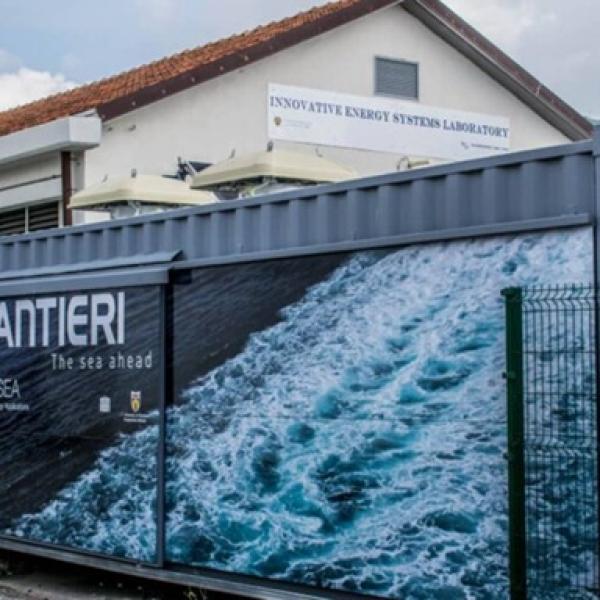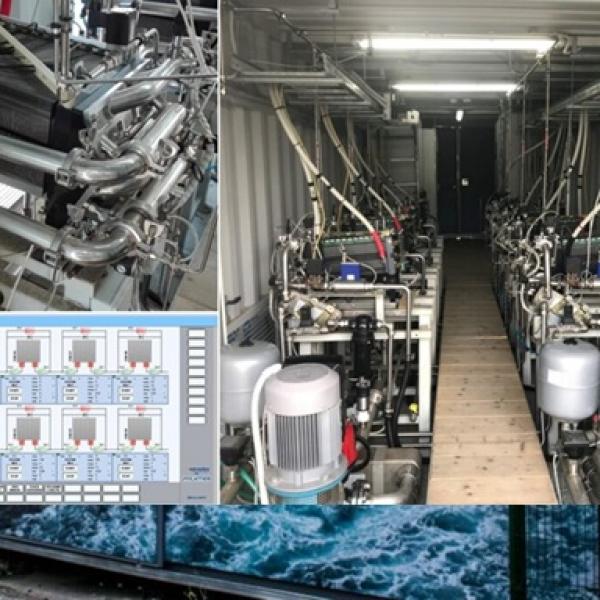The IES laboratory includes a dedicated hydrogen technology testing laboratory (Hydrogen and Fuel Cell Laboratory, H2FC), specifically designed to test fuel cells, electrolyzers, and metal hydride systems. The H2FC laboratory is equipped with a dual air ventilation system, an APU power supply, and a hydrogen sensor, in compliance with safety standards for gas-hazardous areas. In addition, the laboratory is equipped with two direct lines from the gas storage (N2 and H2 tanks compressed at 200 bar) with dedicated pressure reducers capable of operating up to 30 bar, a compressed air line (up to 15 bar), and a water cooling system (up to 1.5 l/s and 3 bar), which is then cooled by 500 kWt fan chillers. Finally, the laboratory is connected to the IES Lab's modular resistive load, used to apply different load profiles to the fuel cells. The H2FC laboratory was recently used (2020–2023) for testing 30 kW and 72 kW PEM fuel cell technologies as part of the TecBIA project. The HI-SEA (Hydrogen Initiative for Sustainable Energy Applications) experimental facility, supported by the University of Genoa through a collaboration between Thermochemical Power Group (TPG) and Fincantieri, continues studies initiated within the TESEO project: High-Efficiency Technologies for On-board Energy and Environmental Sustainability (PON02_00153_2939517). The system was specifically designed to evaluate fuel cell technology applications in the maritime sector; It consists of eight stacks of proton exchange membrane fuel cells (PEMFCs), which feature high energy density and operate at low temperatures, enabling very rapid start-up and shutdown times, making them the most suitable fuel cells for transportation applications. The eight stacks were supplied by Nuvera Fuel Cell and are arranged on two parallel electrically connected branches, within which the stacks are connected in electrical series. The total installed power is approximately 250 kW. The system is completed by other auxiliary components that simulate an installation on board a vessel:
- Fuel cell system installed inside an 8-foot container, easy to move and position
- Non-oil-free industrial air compressor (12 Nm³/min) with filters, with different dynamics than those required for proper fuel cell operation; it simulates the connection of the cathode line to the onboard air line
- Two groups of 16 hydrogen cylinders compressed at 200 bar, simulating the fuel storage system
- A modular resistive load to operate the system according to different operating profiles
- A two-stage cooling circuit to simulate heat exchange with a constant-temperature source (seawater)
The system control system is implemented via an HMI that acquires (at a frequency of 1 Hz) the status of the stack contactors, the cell current and voltages (minimum, average, and maximum) recorded for each stack, cooling circuit temperature data, as well as the flow rates and pressures of the anodic and cathodic flows. A Labview interface has also been developed that allows for the acquisition of certain system parameters at a higher frequency (5 Hz). System monitoring allows for the timely detection of any malfunctions and the adjustment of certain operating parameters. From 2019 to 2021, an in-depth experimental campaign was conducted, leading to several results: the compatibility of auxiliary components with the use of fuel cell stacks was studied; a procedure for recovering the stacks in the event of long periods of inactivity was developed; various steady-state and dynamic load profiles were tested to evaluate the system's suitability for different operating conditions; Some analyses were performed using Design of Experiment techniques to evaluate the interaction and mutual influence between the operating parameters. The polarization curves of each stack were reproduced and tested under various operating conditions, using static, dynamic, and other load profiles similar to those found in the naval sector. The cells were tested both individually and in groups (single branch or complete system) to verify their stability even with the DC/DC converters installed on each branch.
Location
- University Campus: Via Magliotto 2, 17100 Savona
Researchers
- Prof. Loredana Magistri (RADRL)
- Prof. Massimo Rivarolo
- Dr. Matteo Pascenti
- Dr. Silvia Crosa
Research Themes
- Fuel cells
- Electrolyzers
- Metal hydride systems

